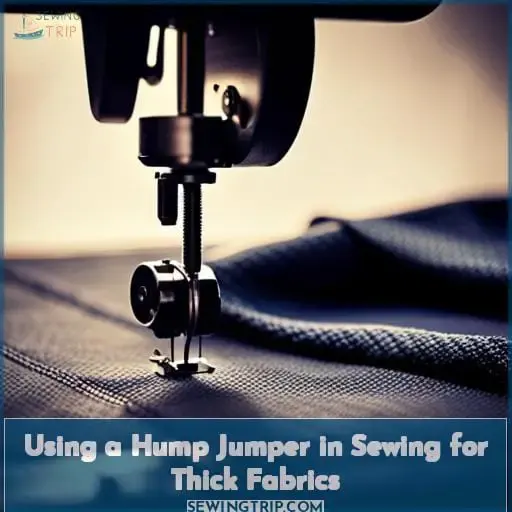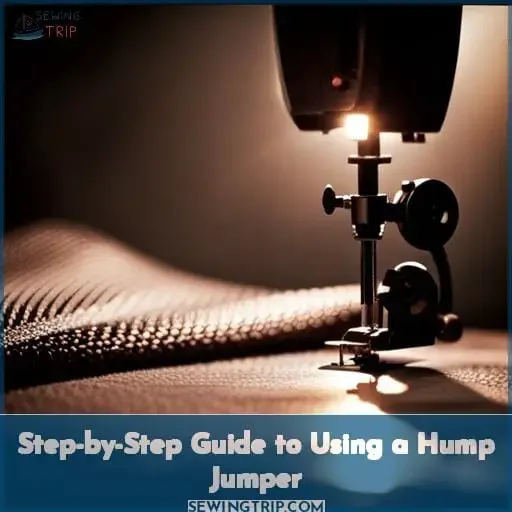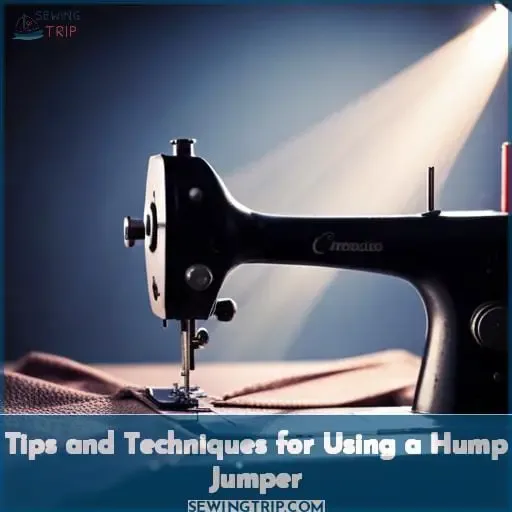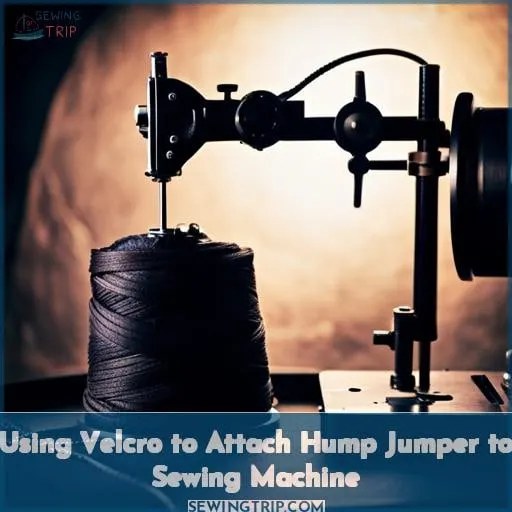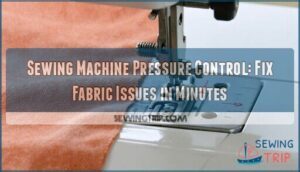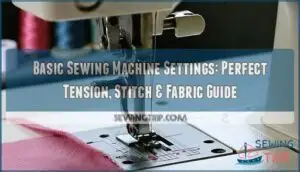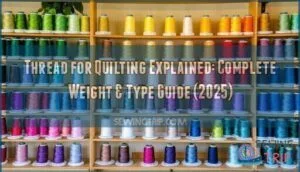This site is supported by our readers. We may earn a commission, at no cost to you, if you purchase through links.
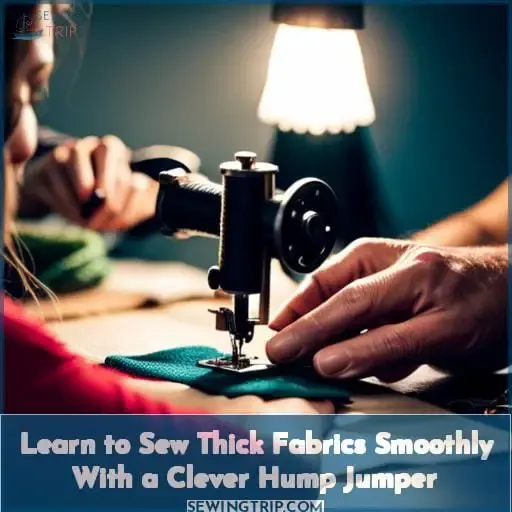 You’ve gotten that awesome thick denim or other heavy fabric home and can’t wait to start your next creation. But as soon as your needle hits that bulky seam, your machine starts skipping stitches.
You’ve gotten that awesome thick denim or other heavy fabric home and can’t wait to start your next creation. But as soon as your needle hits that bulky seam, your machine starts skipping stitches.
This nifty little tool lets you sew smoothly over lumps and bumps by propping up your presser foot just enough to glide over thick seams without crushing them. Once you get the positioning right, it’ll be your new secret weapon for professional-looking stitching on heavyweight fabrics.
Simply wedge the hump jumper behind the presser foot, initiate stitching as usual, then slide it out once you’re past the lump. We’ll walk through exact steps for using a hump jumper successfully. With this clever device, you’ll have that heavy denim whipped into shape in no time.
Now get ready to jump that hump like a pro!
Table Of Contents
Key Takeaways
- Prevents needle breaks and skipped stitches on bulky fabrics.
- Improves stability and stitch placement when sewing heavy materials.
- Make a DIY hump jumper using cardboard from cereal boxes or file folders.
- Position the hump jumper just before bulky fabric areas to ensure even stitches.
Using a Hump Jumper in Sewing for Thick Fabrics
When sewing thick or bulky fabrics, a hump jumper is your best friend. Slip this wedge-shaped tool under the back of your presser foot to ensure smooth, even stitching across seams and multi-layered areas.
Whether you purchase a commercial hump jumper or craft a DIY cardboard wedge, positioning it behind the foot prevents uneven fabric feeding and skipped stitches for flawless results.
Benefits of Using a Hump Jumper
You’ll achieve smooth, even stitches over thick seams when using it. Here are 5 key benefits of using a hump jumper in sewing:
- Reduces needle breaks by supporting thick fabrics.
- Minimizes skipped stitches from uneven fabric thickness.
- Improves stability for precise stitch placement.
- Selects appropriate materials to suit your project needs.
- Stores neatly when not in use to prevent damage.
It’s an essential tool for sewers working with bulky fabrics or layers. Properly using a hump jumper boosts your sewing mastery.
How a Hump Jumper Facilitates Sewing on Thick Fabrics
You feel the foot glide smoothly over the bulky seams as the hump jumper levels it out.
| DIY Cardboard Wedge | Thick Fabric Options |
|---|---|
| Sturdy cereal box | Denim |
| File folder | Canvas |
| Index card | Wool |
The hump jumper facilitates stitching over thick spots like quilt sections. Position this handy tool under the back of the presser foot right before sewing over bulky seams or fabric humps. It keeps the foot level, preventing skipped stitches caused by sewing frustration.
Using a Hump Jumper (Jean-A-Ma-Jig)
Raise the presser foot and slide the Jean-A-Ma-Jig under it, up to the thick seam allowance.
- Position it just before the thick part of the fabric.
- Adjust it to match the fabric thickness.
- Sew slowly over the hump.
- Remove after clearing the thick area.
Keep the Jean-A-Ma-Jig close by to smoothly transition on and off bulky spots. This attachment helps maintain even stitching across different cloth types and textures.
Using a Cardboard Wedge as a DIY Solution
When stitching up those thick spots, keep some cardboard handy for a makeshift wedge behind the foot if lacking a jumper. Cut a wedge from cardboard, making it about 2-3 inches wide and 1-2 inches high.
Size it to the project’s thickness. Reinforce with tape if needed. Place it behind the foot, ensuring it’s clear of the needle. Adjust as required when sewing. With this cardboard wedge, you can wedge thick seams without buying a tool.
Step-by-Step Guide to Using a Hump Jumper
When sewing thick fabrics like denim or canvas, using a hump jumper helps you achieve smooth, even stitches. Before you begin sewing, press the fabric and pin the hems or areas to be sewn. Start stitching but stop just before you reach a thick seam, then lift the presser foot and slide the hump jumper underneath up to the seam allowance.
Preparing the Fabric
Press those hems and pins as if your life depends on it! Before sewing, properly prepare your fabric’s seams and hem allowances to prevent shifting. Clip any extra bulk, then press with a hot iron to flatten the seams. This smoothing ensures that your feed dogs glide evenly, allowing that hump jumper to work its magic.
With a taut and wrinkle-free surface, you can achieve expert results right from the start.
Initiating Stitching
First, place the fabric under the presser foot. Then, start the sewing machine but pause before the thick seam comes under the needle. With your hands on the clutch and fabric, observe the needle lower and stop just before reaching the bulky fabric layers.
Adjust the presser foot pressure so that it sits on top of the material without shifting it. Maintain steady hands on the sewing buttonhole controls and foot pedal until you’re ready to proceed through the thickness ahead.
Positioning the Hump Jumper
Here you go, partner:
Lasso that puckering fabric bulge like it’s a mean old stallion, then scoot your iron pony right on up and saddle that lump with your trusty leather Jean-A-Ma-Jig before it can buck you off into a patchy mess.
- Position yourself behind the presser foot.
- Align with the thick seam.
- Adjust for fabric thickness.
- Keep it nearby for easy removal.
- Replace it when repositioning.
With the hump jumper optimally placed, you’ll be sewing as smooth as silk through the gnarliest denim ridges. Just let your machine glide right over those bulky seams like a hot iron over wrinkled chaps.
Happy trails to flawless stitches, partner!
Continuing Stitching
Keep lowering the presser foot as you slowly sew across the seam with your Jean-A-Ma-Jig tucked underneath. Move the needle thoughtfully through the layers as you focus on your stitching direction, thread choice, and stitch length.
Sandra S. Newman of the sewing community recommends trying different product variants when working with multiple layers. Just be mindful of your technique, and you’ll have that hump jumper working its magic in no time.
Removing the Hump Jumper
Stopping is wise when you reach a seam, then raise that foot and slip the jumper in place. After sewing is done, grasp and slide that hump jumper out from under the foot. Reposition it ahead of that foot for uninterrupted stitching.
When you’re finished using it, properly store the jumper to prevent damage. Cardboard wedges work too, though they may require more manipulation.
Tips and Techniques for Using a Hump Jumper
When sewing thick or bulky fabrics, using a hump jumper is essential for maintaining smooth, even stitches. To get the most out of this handy accessory, there are some key techniques to keep in mind. Adjust its position based on fabric thickness, watch that your presser foot remains level, and leverage the hump jumper’s control over stitch quality.
With practice, you’ll achieve expert results on your heavyweight fabrics. Volume discounts can make stocking up cost-effective if you sew frequently with denim or other thick materials.
Adjusting the Hump Jumper for Different Fabric Thicknesses
You’ll adjust the cardboard wedge behind the foot to support thicker seams yet lift easily when stitching thinner sections. Raise the wedge height for multiple fabric layers or stiff materials. Lower it for thinner or more flexible fabrics.
Adjusting the hump jumper’s position stabilizes stitching across changing fabric bumps. Finding the right height prevents skipped stitches on folds while maintaining control.
Maintaining Levelness and Even Stitches
Watch for skipped stitches if your presser foot remains tilted.
- Position the hump jumper directly behind the presser foot when sewing over thick seams.
- Adjust the hump jumper thickness based on the fabric layers to keep the foot level.
- Check under the foot periodically to ensure the tool is properly supporting the foot’s underside.
- Reposition the hump jumper if you notice shifting fabric or uneven stitches.
Maintaining a level presser foot with the hump jumper prevents skipping and uneven stitches on bulky fabrics.
Enhancing Control and Stitch Quality
By placing the hump jumper ahead of thick seams, you’ll master quality stitching with pride. Positioning the tool properly gives you more control by enabling comfortable settings. With practice, your polishing techniques will shine through any project. Correct needle selection prevents damage, so test materials first.
Potential Volume Discounts and Pricing
Between $4.48 and $4.88 per pack, hump jumpers are reasonably priced sewing accessories that may qualify for additional volume discounts. Some retailers offer bulk pricing on multiple packs to maximize your savings. When purchasing several at once, you may get a promotional coupon code or bundled pricing.
Compare discount offers between retailers for the best deal. Purchasing in bulk allows you to stock up while saving money.
Using Velcro to Attach Hump Jumper to Sewing Machine
Need a handy way to keep your hump jumper in place while sewing thicker fabrics? Consider attaching strong Velcro strips to the bottom of your Jean-A-Ma-Jig and beside the needle on your machine for quick and easy positioning of this helpful tool whenever you need it.
Sandra’s Tip: Using Velcro for Convenience
Secure that helpful hump hopper handy whenever thick fabrics frustrate your foot’s flatness – Velcro’s strength supports your stitching success! Gather leather scraps and hand-sewing needles. Select thread colors complementing pressing hammock shades. Prep ironing technique before attaching Velcro.
Ensuring the Hump Jumper is Always Handy
Attach it to your machine with some Velcro for quick and easy access whenever you need it.
- Place the soft side on the hump jumper.
- Stick the rough side to your machine near the presser foot.
- Ensure no Velcro touches moving parts.
- Check that the hump jumper reaches the foot smoothly.
Now your hump jumper will always be available when sewing heavy fabrics. You won’t need to dig around for it or waste time attaching it each use. Just flip it up, slide it behind the foot, and start sewing those thick seams pronto.
Benefits of Using Velcro Attachment
By fastening the scratchy magic to your machine, you’ll always have the thick fabric helper within reach. The sticky-backed flexibility lets you position the hump jumper in different spots for multiple project uses.
Adjusting the size options and alternative DIY materials is a cinch. Velcro streamlines storage, organization, and access so your sewing endeavors are always enhanced by the handy hump aid.
Frequently Asked Questions (FAQs)
What types of fabrics and projects are hump jumpers most useful for?
Denim and canvas eat needles alive. Steer them smoothly with your hump jumper, a holy grail for mastering thick fabrics. Guide it underfoot before bulky seams, lifting your presser foot across like it’s walking on water.
How can I tell if my sewing machine needs a hump jumper attachment?
Look for uneven stitching over thick seams. If the presser foot can’t glide smoothly across bulky areas, you’ll need a hump jumper to level it out. Skipping stitches and fabric shifting also signal it’s time to try this handy attachment.
What size hump jumper should I purchase?
Purchase the smallest size that fits behind the presser foot. Going too big makes sewing tricky.
Can I sew without a hump jumper if I don’t have one?
Yes, you can sew without a hump jumper, although it will take more skill. Carefully guide thicker seams under the foot, lowering the pressure. Go slowly, stopping often to check stitching. With practice, you will gain the touch to feed bulky spots through smoothly and evenly.
Are there any safety concerns when using a hump jumper?
When using a hump jumper, be mindful of your fingers near the needle. Ensure the hump jumper is properly positioned so the needle clears it. Follow all machine safety precautions and stop stitching if anything feels off. Practice on scrap fabric first to get the hang of it.
Conclusion
Sew your thick fabrics smoothly as silk! With the hump jumper as your sewing sidekick, you’ll glide effortlessly over bulky seams and hems like a needle dancing across denim. Using this clever tool is your passport to the land of even stitches and eased sewing.
Slip it under the presser foot whenever you encounter a bump in the road ahead. Adjust and remove it with nimble fingers, maintaining precision. Stitching mastery awaits – equipped with this simple but transformative accessory.

